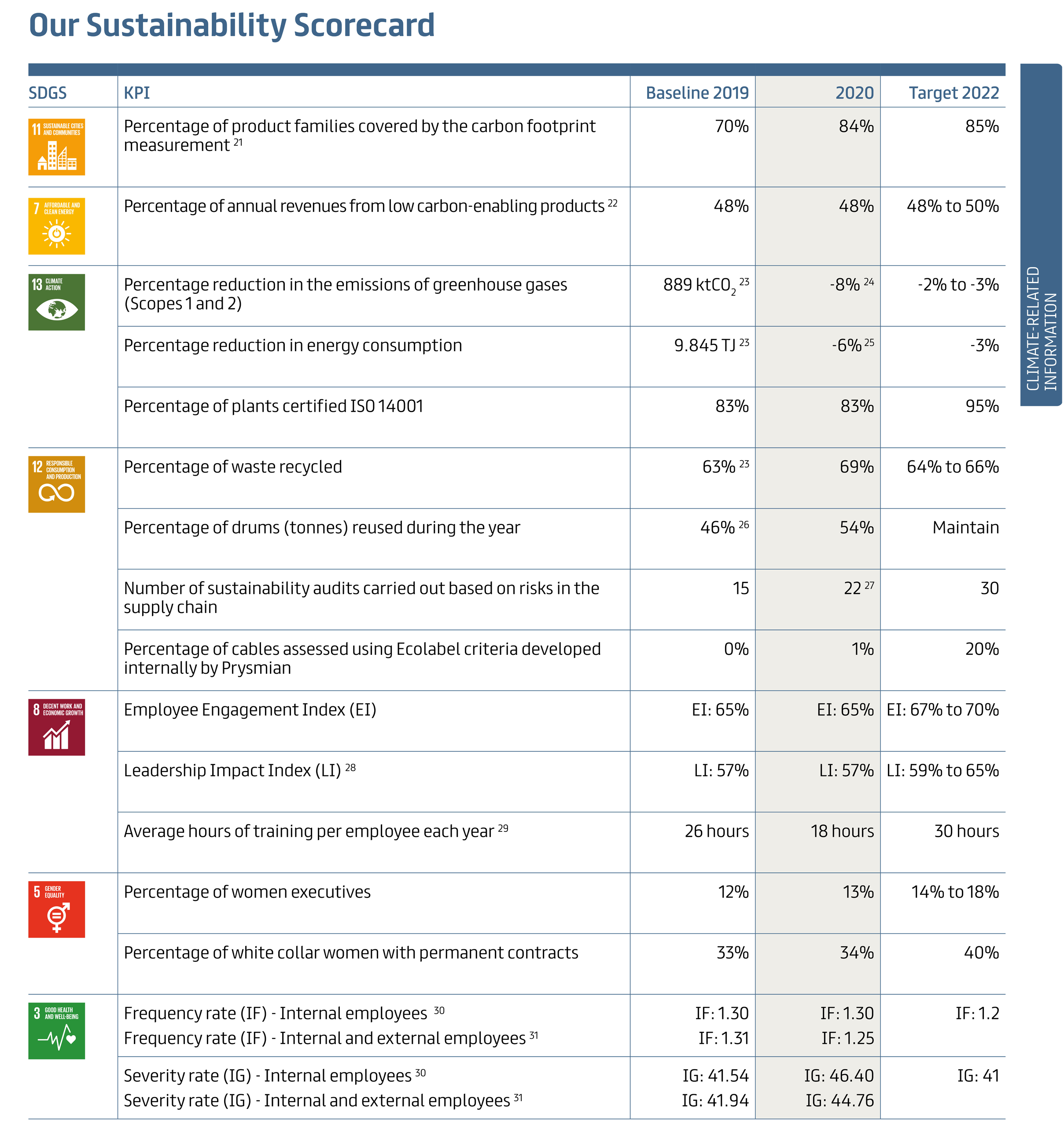Strategy and Targets of the Group

Strategy & Targets
Prysmian incorporates sustainable growth into its business model, beginning on the factory floor. This approach supports the company's Mission and Vision of creating superior cable solutions. It is executed through a governance system designed to achieve a fair balance among all stakeholders in a public company.
An integrated strategy
Prysmian takes a proactive approach to sustainability, focusing not only on evaluating past performance but also on planning for the future. The company recognizes its responsibility toward both the environment and society. To ensure a firm commitment to these principles, Prysmian established key performance indicators in 2016 to continuously monitor progress on medium- to long-term targets. The company regularly updates its action plans based on these targets, showcasing its dedication to continuous improvement.
As an engineering-led manufacturing company, Prysmian's sustainability goals are influenced by a global business environment that increasingly prioritizes environmental and social impacts. These goals align with the Sustainable Development Goals for 2030 as established by the United Nations, involve input from stakeholders, and follow guidelines from major International Sustainability Indexes like the Dow Jones Sustainability Index, FTSE4GOOD, and CDP.
Beginning in 2020, Prysmian linked its long-term management incentive scheme (2020-2022) to the achievement of four Environmental, Social, and Governance (ESG) targets. This strategic alignment between financial and sustainability objectives reflects the company's commitment to sustainability. In addition to financial and shareholder return goals, Prysmian's 2020 Remuneration Policy includes a system of variable stock awards. These awards are linked for 20% to 30% to the gender diversity of the company's executives, the reduction of greenhouse gas emissions, the increase in waste recycling, and employee engagement, as measured by a third-party assessment using the Leadership Impact Index.
SDGs & THE SUSTAINABILITY PLAN
The Sustainability Development Goals (SDGs) are promoted by the United Nations as new global objectives able to support the definition of plans and strategies related to companies’ business priorities. Out of the 17 SDGs, Prysmian identifies 13 Goals that are aligned with its business impact, of which 5 are considered the most relevant: Innovation and Infrastructure (9), Sustainable Cities and Communities (11), Renewable Energy (7), Responsible Consumption (12) and Gender Equality (5). The SDGs are a standard against which the company’s own goals and achievements can be measured. They help Prysmian setting goals and priorities, forming the basis of key performance indicators, along with input that has emerged from stakeholder dialogues carried out every year, starting from 2014 and continuing nowadays, and with requests from sustainability indices.
Following the acquisition of General Cable in 2018, the Group began to implement its own sustainability guidelines and monitoring systems within the new perimeter. This meant that 2018 reporting took place at a time of transition and, therefore, for the sake of continuity with 2017, the sustainability performance of the Group as at 31.12.2018 was limited to the former Prysmian Group perimeter.
At this time, the sustainability priorities have been fully integrated within the former General Cable perimeter, providing a unified strategic vision for the Group. It was necessary to revise the Scorecard following this integration, enabling Prysmian to take account of the change in perimeter and the time required to implement the required sustainability actions throughout the Group. This revision took account of the additional suggestions received following further stakeholder engagement and the latest requirements of the Sustainability Indexes.
The Sustainability Scorecard has been updated to include the General Cable business, revising the KPIs and targets with 2019 as the baseline.
Accordingly, the Prysmian Group now has a new Sustainability Scorecard comprising 16 challenging targets to be met by 2022. The entire process is monitored by the Sustainability Steering Committee, which is chaired by the Chief Operating Officer of the Group.

SUSTAINABILITY GOVERNANCE SYSTEM
From 2016 to 31 December 2019, Prysmian guaranteed its sustainability commitment through the oversight of the Compensation, Nominations and Sustainability Committee, which was appointed to supervise sustainability issues related to the relevant business and its interactions with all the stakeholders. This board-level Committee monitored the company's positioning on the main sustainability indices; advised on the main sustainability initiatives developed by the Group; and approves the Consolidated Disclosure of Non-Financial Information (NFD)/Group Annual Sustainability Report. Starting in January 2020, to coincide with a new set of ESG targets for 2022 and reflecting the group’s strong commitment, Prysmian separated the governance of sustainability issues into a new committee called the Sustainability Committee, distinct from the Compensation and Nomination Committee. It is comprised of three independent directors. It is tasked with the responsibilities mentioned above, as well as putting forward proposals to the board and promoting a culture of sustainability within the group.
At the management level, to underline Prysmian’s commitment on a day-to-day basis across the company, a Sustainability Steering Committee chaired by the Chief Operating Officer (COO) defines and implements the strategy with the involvement of ten corporate functions. Its chief task is to monitor progress on the "Sustainability Scorecard" and compliance with the Group's sustainability policies. In addition, the Diversity and Inclusion Committee defines diversity benchmarks, sets targets, and monitors progress on the matter.
Sustainability policies are coordinated by the Corporate and Business Communications Department, which carries out sustainability reporting and proposes stakeholder engagement activities.
The Corporate and Business Communications Function maps and monitors the expectations of stakeholders concerning the Group. It proposes guidelines and actions, organizes stakeholder engagement activities, and drawing on the multiple resources available, guarantees constant and transparent communications with the stakeholders.



